Don M. Winn's Blog, page 4
January 25, 2022
Look Beneath the Surface of a Child’s Behavior
Look Beneath the Surface of a Child’s Behavior
You can listen to this blog.A recent conversation with a concerned parent reminded me how important it is to look beneath the surface of a child’s behavior. This parent shared that their child was acting out, demonstrating anger and frustration at nearly any request, and showing signs of high anxiety. I listened, asked some questions, and listened some more. Later that day, I imagined how useful a particular gadget from the Star Trek franchise would be for parents—the Universal Translator. Why? Because sometimes the behaviors and voices of our own children can seem as cryptic as if they are speaking a language from another planet.
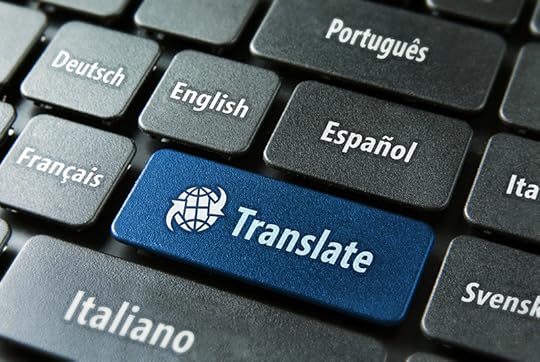
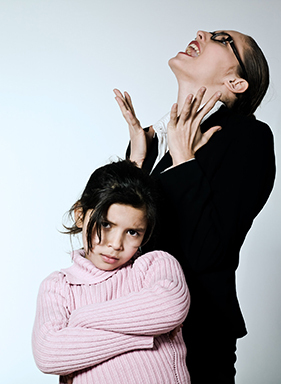
When that’s the case, what is a parent to do? The short answer is to listen with your heart. While it’s human nature to respond to another’s frustration with an outburst of our own (I’ve certainly been guilty of that myself), if we want to truly understand what’s going on, we must restrain the part of ourselves that responds to frustration with frustration and instead focus on getting to the root of the behavior. When a parent chooses to listen with their heart, they are asking themselves, “What must my child be thinking or feeling to make their behavior feel like the right thing to do?”
I was recently acquainted with a helpful triangular diagram that illustrates how the mind works to influence behavior.
At the top of the triangle, it all starts with a thought or a belief. The bottom angles of the triangle are completed with emotion and behavior. To illustrate: if a child is struggling in school, they might have the thought, “I’m stupid! I can’t do this no matter how hard I try!” Those beliefs will of course generate some very powerful emotions, like anger, frustration, fear, hopelessness, or despair. Finally, those negative emotions will drive changes in that child’s behaviors, such as checking out via digital media and devices, giving up, exhibiting oppositional or defiant actions, changing sleeping or eating patterns, showing loss of joy in previously loved endeavors, and of course, showing symptoms of anxiety.
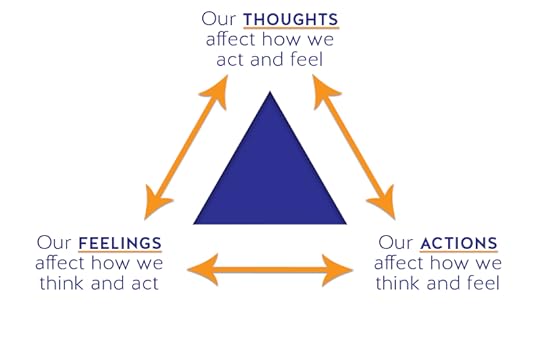
It’s also possible that your child is being bullied or being made fun of. Or maybe there is a focus issue or a sensory processing overload of some sort. Any of these experiences or combinations thereof will generate that triangle of events—thoughts or beliefs that circularly influence emotions and behaviors. But unless a caring adult stops to look beneath the surface of a child’s behavior, they will never know the underlying cause of what’s troubling that child.
The point is this: every change in a child’s behavior is significant and presents the caring adults in the child’s life with an opportunity. Instead of only addressing behaviors, look beyond the behaviors at the emotions and the beliefs that generated them to discover what the child needs most at that moment. I have often said that when a child can’t come up with a solution to a problem, they conclude that there isn’t one. I don’t believe it’s an oversimplification to state that many of the troubling behaviors we may see in children—including symptoms of anxiety—often stem from the hopelessness children feel when they draw that conclusion.
So, once you’ve listened with your heart, what comes next? Address the beliefs and the feelings they have generated. What conclusions (beliefs) has your child formed based on their experiences? That they’re stupid and can’t learn? That if they raise their hand to ask for clarification they will be ridiculed or bullied? That they are broken? That the ability to perform academically according to expectation dictates who is allowed to be safe and loved? That they are a failure? That their worth as a human being is determined by how ‘‘smart” they are? There are so many possible beliefs children may assume are true about themselves, but you get the drift. Each inaccurate conclusion/belief requires gentle redirection so that the child’s emotions can be soothed.

But what is a parent to do if their child is shut down emotionally, perhaps having so much anxiety based on the inaccurate conclusions they’ve drawn about themselves that they are overwhelmed or unable to find the words to describe what they are experiencing? Here’s where sharing moments from your own childhood can build a bridge between the two of you. When you share stories of times that you came to a conclusion about what an experience in your own life meant, and how much anxiety it caused you, and how much it would have meant to you to be able to share those burdens with someone else, you help reinforce to your child that they aren’t a freak of nature, but that what they feel and how they are responding to their thoughts and feelings are part of being human.
Your patient interest will help your child realize that they aren’t alone in this, and that even if the next step isn’t clear right at that moment, you will work on it together to discover a solution or work-around.
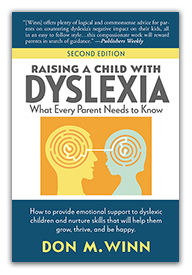
Many parents are unclear what “social and emotional learning” or “social and emotional support” look like. The process described above is the answer. Of course, this material just touches the tip of the iceberg, as it were. For a more in-depth consideration of action steps and helpful sample conversations, please refer to my archived blogs on dyslexia, and my book, Raising a Child with Dyslexia: What Every Parent Needs to Know.
So if a child starts acting out in unexpected ways, it’s time to investigate. Talk. Listen. Look beneath the surface of a child’s behavior. You’ll be glad you did, because it will equip you to help your child through whatever difficulties they are currently facing.
Cardboard Box Adventures picture books are great for shared reading and can help parents establish a strong preliteracy foundation for their children. Check out the CBA Catalog for a full list of award-winning picture books, chapter books, and resources for parents and educators. Visit my Amazon author page for more information.
The post Look Beneath the Surface of a Child’s Behavior appeared first on Author Don Winn's Blog.
January 12, 2022
Exploring Fort Davis National Historic Site
A Trip in Time: Exploring Fort Davis National Historic Site Part 2
You can listen to this blog.Welcome to part two of my exploration of the Fort Davis national historic site. As I mentioned in part one, it’s very important for my readers to understand ahead of time that when I write about any of my travels where I explore history, it in no way constitutes an agreement with or endorsement of the choices, ideals, or actions of our forefathers. Discussion of the environmental, cultural, and social implications of their actions is far beyond the scope of this blog. Instead, I strive to share glimpses of history that I hope will inspire readers to get curious about what life was like for those who lived before us—their joys and sorrows, their grit and tenacity, and how their lives and ours are alike, yet so very different.
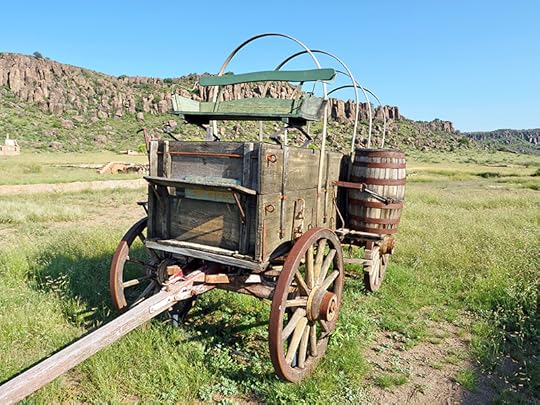 Westward expansion meant many months spent in one of these – Fort Davis Historic Site
Westward expansion meant many months spent in one of these – Fort Davis Historic SitePhotograph copyright Elizabeth Winn
Travel with me back to 1849. Imagine yourself beside US army Lieutenants William Farrar Smith and William Henry Chase Whiting, engineers charged with a monumental task. They were assigned to survey a military route through the wilderness of West Texas. The route had to be manageable for people traveling west to California from San Antonio. They were also looking for suitable sites for frontier military posts. After graduating from West Point in 1845 (Whiting was first in his class, Smith was fourth), both men headed west to begin their assignment. It involved several years’ worth of dangerous, challenging travel.
After many months of scouting and evaluating, the men found themselves west of the Pecos River. Their priority? Finding a source of clean water. As they climbed ever higher in the mountains, the pair finally came upon a small creek brimming with clear, cold water. It ran through a box canyon for several miles. Giant cottonwood trees adorned its banks, and beyond the trees, they found plenty of flat grassland for grazing between the creek and the surrounding mountain peaks. This wasn’t the first time this land had felt the presence of man; the cottonwood trees and the walls of caves and overhangs in the canyon were covered in Native American pictographs.
Whiting named the creek Limpia which means “clean” in Spanish, and for a time, the mountains were called by that name as well. The canyon he dubbed Wild Rose Pass for the explosion of blooms that perfumed their passage, and he gave their camp the name Painted Comanche for its artwork. Both engineers moved on to survey other regions, but their discovery set the wheels in motion for the birth of many forts and camps across the wild frontier of Texas, including what would become Fort Davis.
By 1854, the army had stationed six companies of the Eighth Infantry in this idyllic spot. They busily constructed buildings for each company as well as officers’ quarters, a bakehouse, a blacksmith shop, an infirmary, and other necessary works to support a post of this size and importance. It was named Fort Davis after US Secretary of War Jefferson Davis.
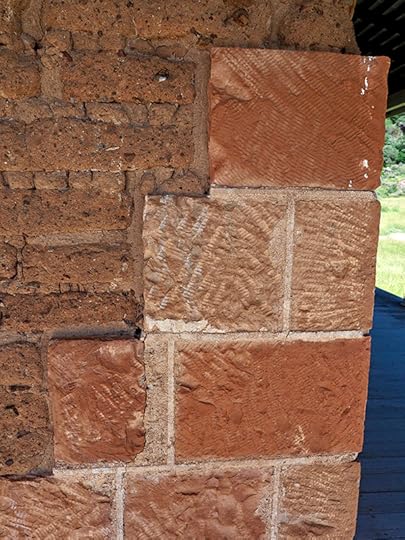 Every stone was cut by hand.
Every stone was cut by hand.Photograph copyright Elizabeth Winn
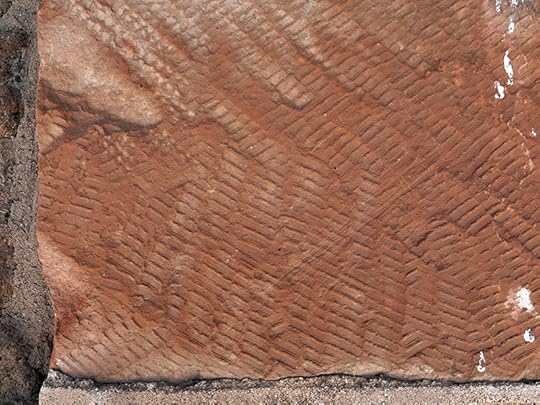 The chisel marks of a true craftsman.
The chisel marks of a true craftsman.Photograph copyright Elizabeth Winn
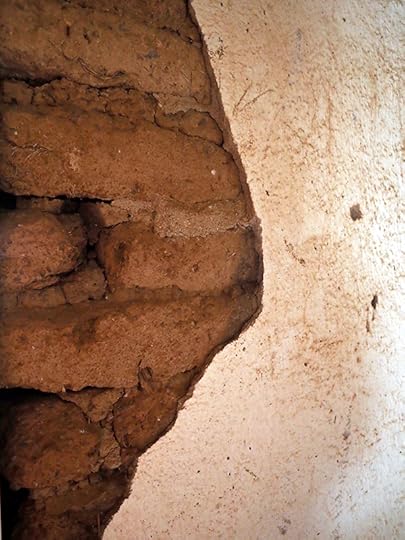 Handmade adobe bricks with crumbling plaster in the hospital.
Handmade adobe bricks with crumbling plaster in the hospital.Photograph copyright Elizabeth Winn
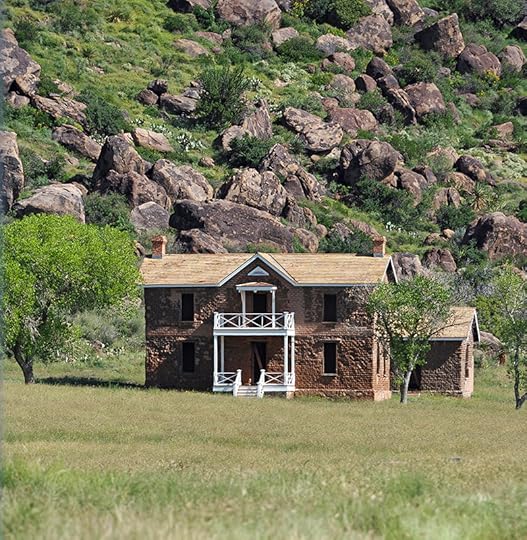 Huge boulders loom behind this officers quarters.
Huge boulders loom behind this officers quarters.Photograph copyright Elizabeth Winn
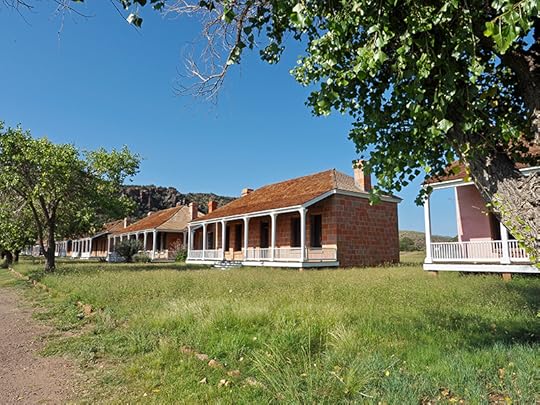 Officers’ quarters
Officers’ quartersPhotograph copyright Elizabeth Winn
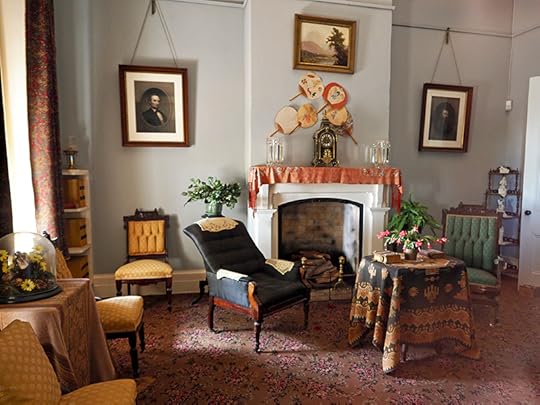 A parlor from the officers’ quarters
A parlor from the officers’ quartersPhotograph copyright Elizabeth Winn
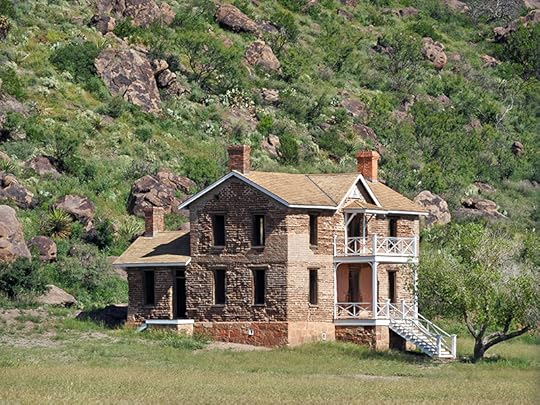 Some officers had very large quarters since their families lived with them.
Some officers had very large quarters since their families lived with them.Photograph copyright Elizabeth Winn
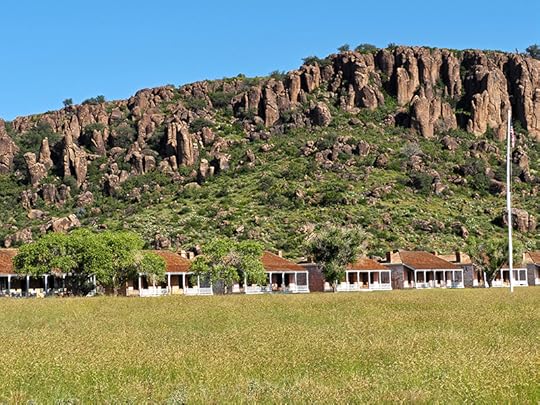 Officers Row with Sleeping Mountain background
Officers Row with Sleeping Mountain backgroundPhotograph copyright Elizabeth Winn
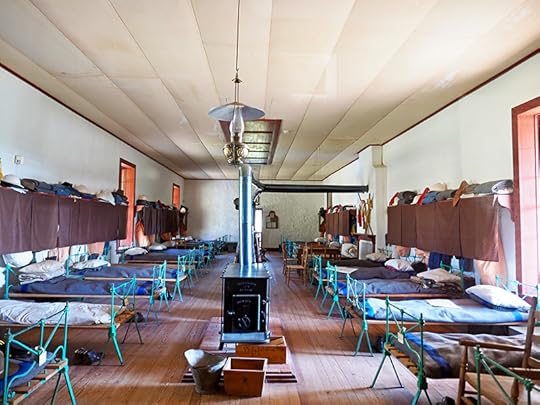 There were dozens of buildings for the barracks like this one. The whole site is full of old foundations. Photograph copyright Elizabeth Winn
There were dozens of buildings for the barracks like this one. The whole site is full of old foundations. Photograph copyright Elizabeth Winn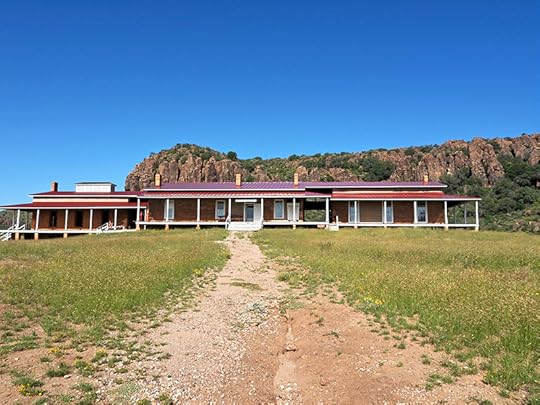 Hospital
HospitalPhotograph copyright Elizabeth Winn
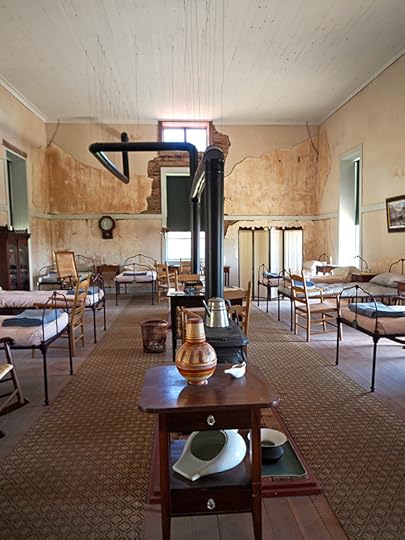 Hospital interior. The surgeon general required each patient to have 1200 ft.³ of fresh air for optimal wellness and recovery, and so the hospital had massively high ceilings.
Hospital interior. The surgeon general required each patient to have 1200 ft.³ of fresh air for optimal wellness and recovery, and so the hospital had massively high ceilings.Photograph copyright Elizabeth Winn
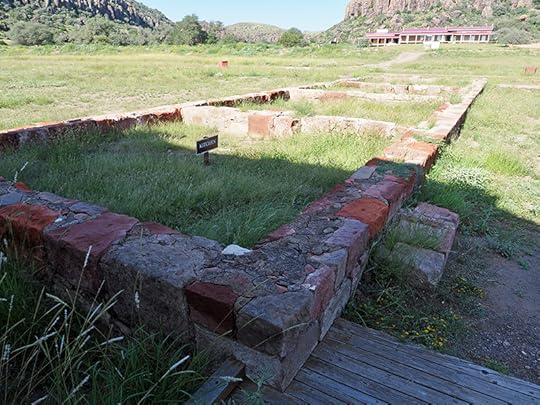 Foundations of old kitchens with the hospital in the background.
Foundations of old kitchens with the hospital in the background.Photograph copyright Elizabeth Winn
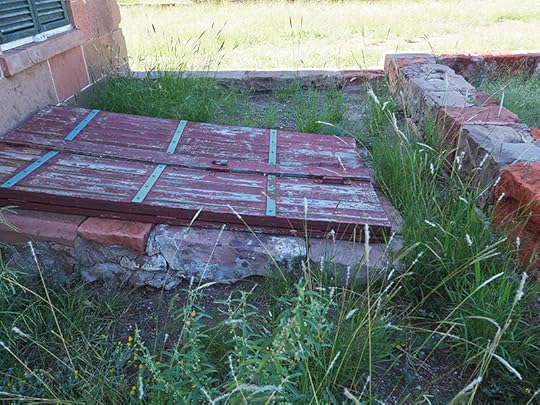 Root cellars stored vegetables growing in the gardens since there was no refrigeration.
Root cellars stored vegetables growing in the gardens since there was no refrigeration.Photograph copyright Elizabeth Winn
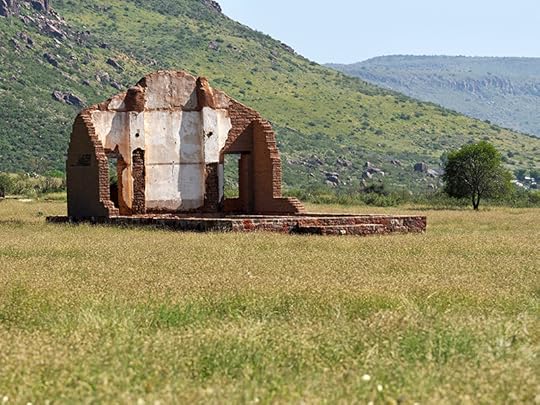 The remains of the chapel
The remains of the chapelPhotograph copyright Elizabeth Winn
In the years between 1854 and 1861, the Eighth Infantry spent most of their time pursuing the Kiowa, Apache, and Comanche and serving as protectors of westbound travelers.
All that activity suddenly stopped when Texas seceded from the Union at the outbreak of the Civil War. Fort Davis lay deserted for five years after briefly being occupied by Confederate Soldiers. By June 1867, Lieutenant Colonel Wesley Merritt and four companies of the Ninth Cavalry took up residence and moved the camp out of the canyon to its current location in front of the Sleeping Lion Mountain. It was a mammoth undertaking. Over the next dozen years, they constructed over 100 buildings, including officers’ quarters and barracks to house 400 men, some of whom had families.
After many campaigns, the Comanche were defeated in the mid-1870s, but the Apache continued to raid and make travel unsafe through 1881. In a two-year series of engagements, Apache chief Vittorio and his tribe were driven into Mexico where they perished at the hands of the Mexican army. It was the last time US troops engaged Native Americans in the region.
Fort Davis continued to be an important outpost until June 1891, patrolling in search of bandits, offering safe passage to railroad survey crews and telegraph repair crews, and keeping the roads in a safe condition. Seventy years later, in 1961, it was added to the United States National Register of Historic Places in the National Parks Department.
Cardboard Box Adventures picture books are great for shared reading and can help parents establish a strong preliteracy foundation for their children. Check out the CBA Catalog for a full list of award-winning picture books, chapter books, and resources for parents and educators. Visit my Amazon author page for more information.
References for learning more about the Fort Davis national historic site:
https://books.google.com/books/about/Exploring_Southwestern_Trails_1846_1854.html?id=GbMTAAAAIAAJ
https://www.texasbeyondhistory.net/forts/davis/camp.html
https://www.texasbeyondhistory.net/forts/davis/trails.html
https://www.nps.gov/foda/planyourvisit/hours.htm
The post Exploring Fort Davis National Historic Site appeared first on Author Don Winn's Blog.
January 5, 2022
Exploring Fort Davis, What Came Before
A Trip in Time: Exploring Fort Davis Part 1, What Came Before
You can listen to this blog.When I was a kid, nothing captivated me more than stories about the westward exploration and expansion of this nation. The time period was singular in that adventure, exploration, exposure to new cultures, new terrain, and new forms of life were open to any who had the spirit to embark on the journey. The price of admission was stamina, a willingness to leave familiar comforts (and people) behind, and boundless courage to face the Great Unknown. So you can imagine that when I had a chance to travel to West Texas last year, I was excited to have the opportunity for exploring Fort Davis and the areas surrounding it. It is a beautiful, but occasionally desolate area.
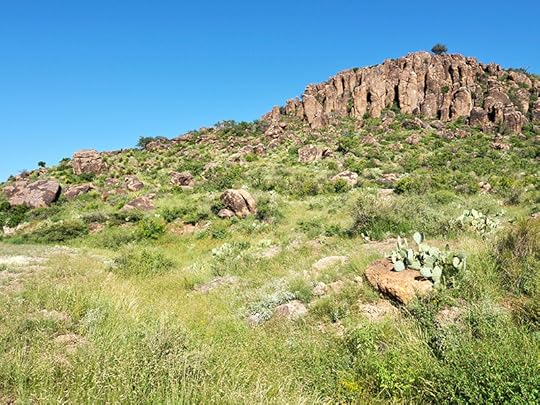 Davis Mountains near Fort Davis.
Davis Mountains near Fort Davis.Photograph copyright Elizabeth Winn
I like to imagine myself living somewhere back in time and then to compare it with what I know about life today.
For example, today, for the most part, getting lost is a thing of the past. We have phones that can ping our exact location thanks to communication with satellites. So it might be difficult to imagine that just a couple of hundred years ago, once a person traveled any farther west than New York, Philadelphia, or Richmond, maps consisted of nothing but blank space. Very few intrepid souls had ventured past the thirteen colonies, and even fewer returned to tell their tales and describe what they had seen.
The terrain wasn’t the only unknown. Explorers faced hazards at every turn. Hundreds of fascinating and previously unknown species of animals, insects, and reptiles filled the west. Often, a person’s first brush with an unrecognized life form was their last. There was little, if any, frame of reference. Lack of medical care made westward expansion even more dangerous.
 Lots of hazardous plants in Alpine, Texas.
Lots of hazardous plants in Alpine, Texas.Photograph copyright Elizabeth Winn
In contrast, in our lifetime, easy identification of flora and fauna is just a click away on your phone. If you want to make sure you won’t need a bottle of calamine lotion later in the day, you can snap a picture in any of dozens of apps to rule out poison ivy. Or if you need to know about the poisonous possibilities of a spider or snake, a quick question to Siri or Google provides you with an instant response.
Reviewing the history of this time period is a fun hobby of mine, as is traipsing around the remnants of towns, forts, and encampments long abandoned by those who came before us. However, before I continue, it’s important for my readers to understand that my explorations of the past in no way constitute an agreement with or endorsement of the choices, ideals, or actions of our forefathers. Discussing the environmental, cultural, and social implications of their actions that still send shock waves throughout society today is far beyond the scope of this blog. Instead, I strive to share facts from history that I hope will inspire readers to get curious about what life was like for these pioneers—their joys and sorrows, their grit and tenacity, and how their lives and ours are alike, yet so very different.
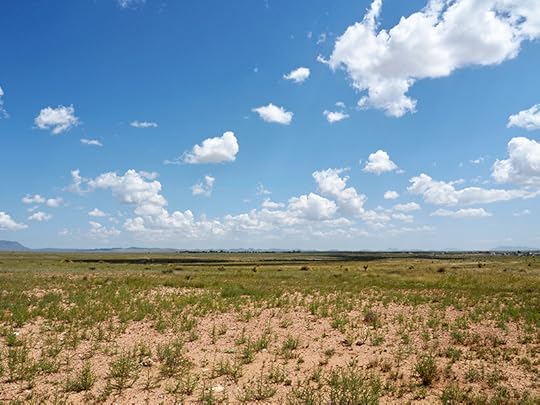 Wilderness vista near Marfa, Texas. Photograph copyright Elizabeth Winn.
Wilderness vista near Marfa, Texas. Photograph copyright Elizabeth Winn.The westward expansion in Texas took its biggest leap forward during the mid-nineteenth century, after gold had been discovered in California. Once people were bitten by the gold bug, they couldn’t get across Texas fast enough, and the Trans-Pecos Trail was born. Stretching from San Antonio to El Paso, the Trans-Pecos Trail was also crisscrossed in multiple places with much older trails going north and south between Mexico and the so-called “Indian Country,” which in this case was located in the Texas Panhandle and parts of Oklahoma.
In the eighteenth century, the Comanche and Kiowa peoples often traveled south to Mexico to trade buffalo hides for corn and other dietary staples. To the east and west, their routes were bordered by Apache land. The Lipan Apache had the territory to the east of Comanche and Kiowa country, and the Mescalero Apache laid claim to the territory of West Texas, stretching west from near the Davis Mountains to what is now El Paso.
For about two hundred years before this, the Spaniards had been on a quest to capture as much wealth and land for their crown as possible. They had embarked on ambitious campaigns all over South and Central America, Mexico, and the southern United States.
In addition, outlaws and highwaymen scouted for commonly used trails where they could lie in wait for passersby. No matter what a person’s heritage might be, everyone back then traveled with the supplies they needed to survive as well as any valuables they might possess, and that made travel of any sort risky due to the danger of robbery.
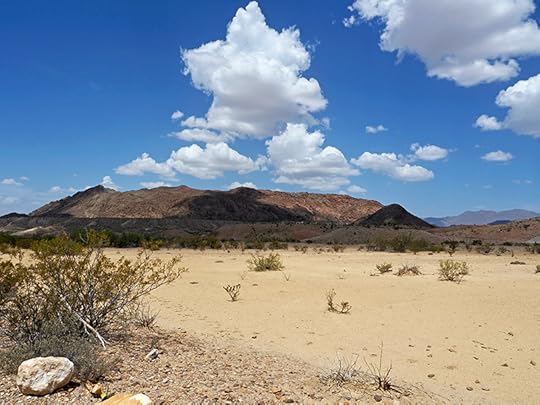 The often fruitless search for water near Big Bend.
The often fruitless search for water near Big Bend. Photograph copyright Elizabeth Winn.
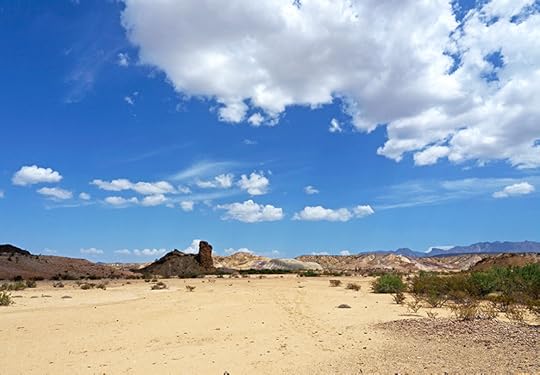 More dry creek beds in desolate wilderness near Big Bend.
More dry creek beds in desolate wilderness near Big Bend.Photograph copyright Elizabeth Winn
With so many people competing for survival and primacy, the US government made a plan to make travel safer for people moving west. And as anyone who has been to West Texas knows, water is in short supply. So it was a natural and strategic choice to establish camps and forts in areas where springs, creeks, and rivers provided water and offered grazing for pasture animals. All the older travel routes—no matter who had blazed them—went from water source to water source, making them the places where travelers needed the most protection.
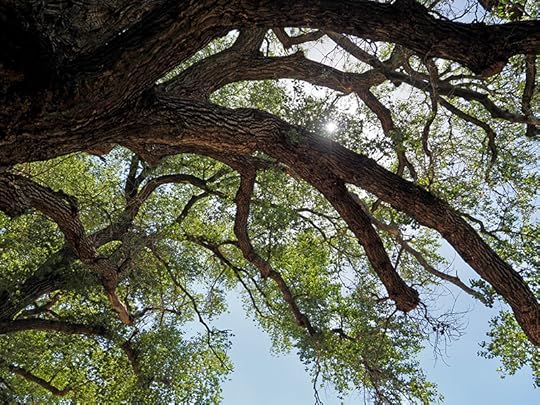 Huge trees near the waterways provide shelter in the Davis Mountains.
Huge trees near the waterways provide shelter in the Davis Mountains. Photograph copyright Elizabeth Winn
I hope you’ve enjoyed this article about exploring Fort Davis. In part two of this series, we will take a look at Fort Davis, one of the best-preserved forts remaining from that system of forts and camps built by the US government for the protection of travelers venturing westward.
Cardboard Box Adventures picture books are great for shared reading and can help parents establish a strong preliteracy foundation for their children. Check out the CBA Catalog for a full list of award-winning picture books, chapter books, and resources for parents and educators. Visit my Amazon author page for more information.
References for learning more about exploring Fort Davis:
https://www.tshaonline.org/handbook/entries/comanche-indians
https://www.tshaonline.org/handbook/entries/kiowa-indians
https://www.tshaonline.org/handbook/entries/apache-indians
https://www.tshaonline.org/handbook/entries/exploration
https://www.texasbeyondhistory.net/forts/davis/trails.html
The post Exploring Fort Davis, What Came Before appeared first on Author Don Winn's Blog.
December 14, 2021
Fun Science with Daniel G. Benes
Fun Science with Daniel G. Benes – Interview with Award-Winning Science Popularizer Daniel G. Benes.
For so many kids who struggle with learning or focus issues, the learning environment needs to be especially dynamic to capture their full attention and inspire them. That is even more true for subjects like science, which may often be presented in a dry, factual manner. So when I came across the work of award-winning science popularizer Daniel G. Benes, it made me wish that every child could have the opportunity to learn about science, physics, and other technical subjects from someone who has this much passion for them. Daniel has graciously agreed to be interviewed for this blog and I’m thrilled to be able to share his story with you. I hope you enjoy learning about fun science with Daniel G. Benes.
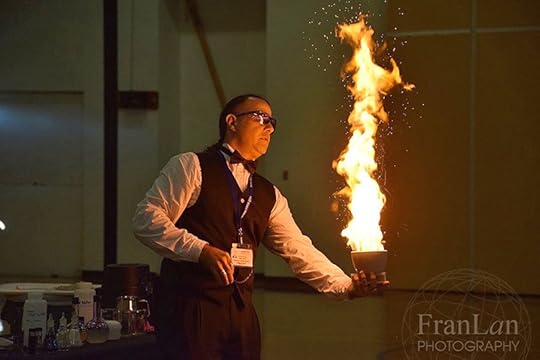
Don: How did you develop a love for science and experimentation?
Daniel: From as early as I can remember, I was ridiculously curious about the world around me. My first memory is slamming my face into a chocolate cake. So, yeah, I did that. But that only inspired more curiosity. If I didn’t understand something, I’d stare at it, poke it, prod it, flip it upside down, shake it, and hopefully not catch it on fire, until I found an answer. Sometimes I would catch it on fire. I still do that today, but usually by request.
My favorite thing to do was take appliances apart, especially anything with high-voltage vacuum tubes. When I was about five or six years old, I used my mom’s tools to take apart and “fix” one of her lamps that wasn’t broken. After reassembling it I proudly handed her a bowl of leftover parts and told her that the lamp didn’t need them. I did the same thing with her vacuum cleaner. She was a patient woman.
To this day there are very few objects in my home or workshop that I haven’t taken apart to see what glorious wizardry lives inside.
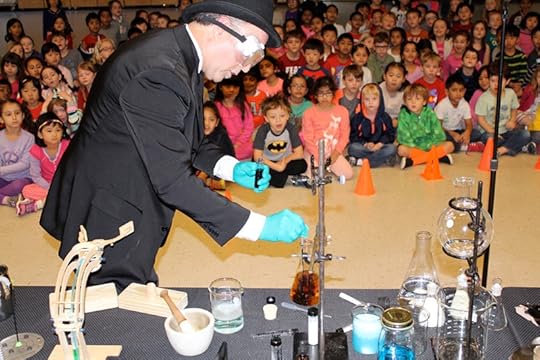
Don: I’m familiar with the acronym STEM, but in your demonstrations, you mention the acronym STEAM. Would you please explain this term to our readers?
Daniel: Yes, I prefer STEAM over STEM. For those who don’t know, STEM is an acronym made from the words Science, Technology, Engineering and Math. Honestly, there are more thorough and inclusive acronyms available, but there’s not enough room on my business card.
Children are natural-born explorers with their curiosity knobs turned all the way up to eleven. A child’s field of research is the outer frontier’s edge of curiosity, where monumental discoveries are made minute by minute. They will mix things together that shouldn’t be mixed, pull things apart that shouldn’t be pulled apart, and will voluntarily yeet any object across a room just to study its flight and impact characteristics and laugh at the crash.
But children are also very good at something else. And this where the A fits into STEAM. Children are born creative, expressive artists and designers. From the moment kids discover that one object can leave a mark on another object (such as a Sharpie on a dining room wall) they will make art.
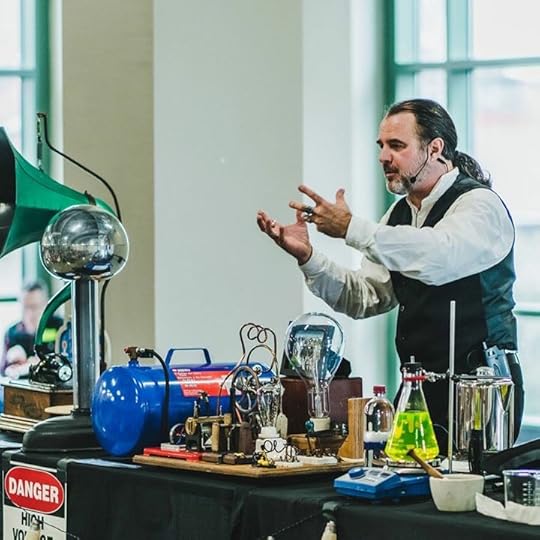
I’ll sum it up with a little poem I wrote years ago:
“Sure, STEM is cool.
It’s calculated and smart.
But STEAM is much better,
Because it has heART.”
~Daniel G. Benes
Don: I love how you combine your demonstrations with antique aspects of science and technology. How did you come up with the idea of combining antique tools and processes with your work? In my opinion, I would say this definitely qualifies as fun science with Daniel G. Benes.
Daniel: My science shows actually came about because of my love of antique science and technology and collecting antiques. Over time, my collection of antique science and technology eventually became a small museum and I soon realized that many of the things in my collection were way too cool to keep to myself and held such important historical significance that I had to share that joy and history with others!
My show-and-tells started as annual Halloween “mad science” parties at our house. We’d often have thirty to forty cars parked along the road. We even had a guest magician one year. Things ramped up when I was asked to help produce a Halloween Ball at pianist James Dick’s famous Festival Hill in Round Top, TX, where I built and hosted a working Frankenstein’s Lab and performed dangerous high-voltage shows on the hour throughout the event.
That, along with my collection of original Thomas Edison antiques, led to one of the producers offering me the leading role as Thomas Alva Edison in a stage production about Thomas Edison and Nikola Tesla. That led to me appearing in the New York Times and Texas Monthly. I want to add that I performed all of these events for no charge.
I continued to volunteer for more public events, including Maker Faire Austin and SXSW Interactive. I never said no to an opportunity and worked hard to improve my presentations and I enjoyed every new adventure! Eventually large public schools and public libraries began to take notice and started asking me to perform shows. That’s when I began to accept the idea that I might actually have a real show on my hands.
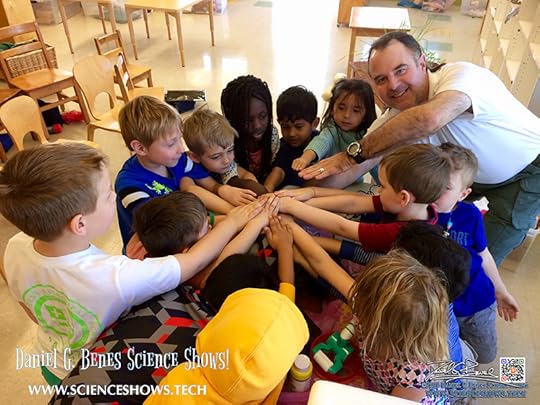
I started adding state-of-the-art physics and chemistry demonstrations and eventually a script sprinkled with audience interaction and humorous improv. This eventually led to TV and radio appearances and the incredible and humbling honor of being called a celebrity science popularizer and host with an equally incredible list of amazing clients and sponsors on my website.
My shows and events have won awards and I have branched into designing and teaching science enrichment programs, but I have vowed to always include antique science and technology in all my shows and events.
Don: What are your favorite demonstrations that involve math or physics?
Daniel: If I’m being honest, math is my least favorite subject. In fact, if being great at math was a requirement for inspiring kids, I’d seriously have to find something else to do.
As for my favorite physics demos, I’d have to say it’s demonstrating the Bernoulli and Coanda effects by hovering and controlling various objects in the air using both the world’s smallest and cutest electric leaf blower, at only six inches long, and a full-sized electric leaf blower. In fact, I recently upgraded this demo, and now use the world’s most powerful electric leaf blower with over 180 mph winds at 650 cubic feet per minute, about 100 bathtubs worth of air each minute!
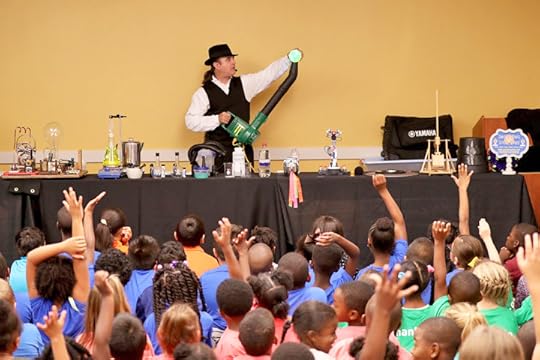
Don: What are your favorite chemical experiments?
Daniel: Anything that involves reactions with copper because of the blue colors they can create. However, metals can be toxic. A lot of time and research went into finding some colorful stage-worthy chemical reactions that I could reliably perform in schools, libraries, and museums that are beautiful and exciting, but most importantly, safe. Two of my favorites are known as color-changing potential of hydrogen (pH) reactions, nicknamed the Blue Bottle Reaction, which changes color between clear & blue, and the Traffic Light Reaction, which changes color between yellow, red, and green.
I did not invent these two types of reactions, but I have definitely turned their presentation into a one-of-a-kind unique art form! And there’s the A in STEAM!
Don: You mention that your mom always encouraged you—how did her response to your childhood experiments make a difference? And what advice would you give parents today who have curious children?
Daniel: I’ve actually mentioned my mom in public on many occasions. In fact, there are many videos out there where I’ve invited students to join me in shouting, “Hi, Mom!” at the beginning of various shows. Giving credit to parents is important to me.
My mom, Mary J. Vander Meiden, is a lifelong music teacher, educator, musician and professional classical violinist. She played with Van Cliburn and opened for Bob Hope. I watched her on TV as a kid. She taught and inspired many, many thousands of kids besides me. She was the role model for the enthusiasm that instilled and inspired my love of music, photography, and science, which eventually led to me becoming an award-winning keyboardist/Native American flute performer and World/Ambient music composer (my music is actually played throughout St. David’s Hospital every time a baby is born), an award-winning photographer, and eventually an award-winning science popularizer and show host.
It may sound cliché, but it all starts at home by fostering an environment that invites curiosity and instills enthusiasm for imagination and exploration and does not prevent it or shut it down. Children learn what they live. Inspire them by being an inspiration! One of the best things you as a parent can do is to model your own passion about something you love doing! It’s exciting to be around a person who is passionate about something they do. Never underestimate the value of hobbies. YouTube is filled with comments saying, “I may not understand what you’re doing, but I loved watching you do it!”
Have faith in yourself as a parent and don’t let your own fears prevent you from being an amazing teacher! Empower your kids! Teach them how to use hand tools and power tools, ensure their safety and promote the use of safety equipment at every step, but then step out of the way and let the magic happen!
One of my favorite quotes by Thomas Alva Edison is: “If parents pass enthusiasm along to their children, they will leave them an estate of incalculable value.”
Don: How can parents and educators foster a love for STEAM in kids?
Daniel: Remember that kids are born scientists and artists. They just need the environment, the tools, the guidance, and the encouragement of a “coach” that is willing to get in the game with them, but then get out of their way and understand that bumps and bruises are a normal part of a good game.
Adults often forget that as former children, we are 100% experienced and qualified to teach children. Not everybody is a great teacher. But everybody has something great they can teach.
Don: You’ve mentioned that some kids seem less interested in science than others in your audience. When you notice that a child’s imagination hasn’t been captured, how do you reach them? Would you give us an example of a child who has responded to science with some extra help?
Daniel: I accept the fact that not everything I present or teach is going to appeal to everybody. Besides live shows, I also design and host some amazing science enrichment programs at various private schools for children ages three to twelve. One of the ways that I prepare for success is that on the first day of class I have students introduce themselves and share their favorite topic or hobby with the class. I take note of these things and will often sneak them into the curriculum if someone needs a little extra inspiration.
For example, there was one student enrolled by his parents who didn’t seem to have a lot of interest in science, but I knew that he liked Minecraft. I happen to be a big fan and player of Minecraft myself. So during one of my classes where we were exploring minerals and metals, I handed out a square of aluminum foil to each student and showed them how to hammer it into a Minecraft block! He loved it so much he couldn’t wait to show his parents!
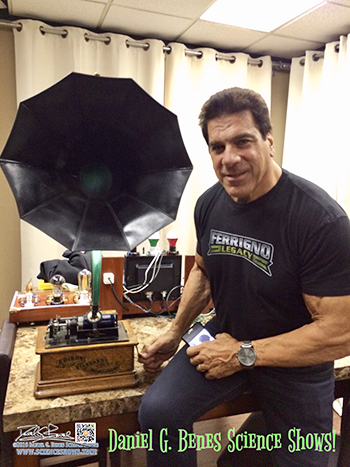
Don: Your work has caught the eye of lots of internet and television stars. Would you please share a favorite experience with us?
Daniel: My love for science and teaching has opened some amazing doors and has allowed me to experience moments that I never dreamed would happen, including being featured in magazines and on television and the radio.
One of my coolest experiences was when I was scheduled to appear on the show, We Are Austin, which was filmed in the CBS building in Austin, TX. I had brought a few items from my show, including my famous original 1905 Thomas A. Edison cylinder phonograph record player.
I had just been escorted into the green room, where guests can relax and have some coffee before the show, when I recognized two of the other guests in the room who were appearing on the same show with me. One was Lou Ferrigno, the original Incredible Hulk from the TV series from the 70s and 80s. The other was Phil Rosenthal—the creator, writer, and executive producer of Everybody loves Raymond! I got to chat with both of them and even took a few pictures.
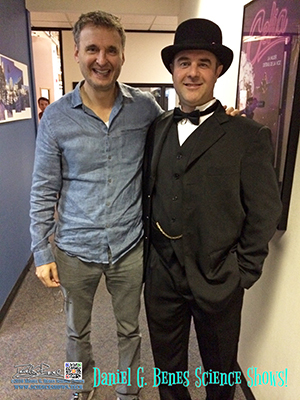
For me, two major highlights were when the Incredible Hulk himself, Lou Ferrigno, asked to have his photo taken next to my Edison cylinder phonograph player, with its famous green horn, and when Phil Rosenthal filmed me playing a 120-year-old cylinder record on it and tweeted the video all over Hollywood! The video was seen by quite a few A-list celebrities and is still online.
Another fantastic highlight was when I got to hang out with the amazing and inspirational Adam Savage of Mythbusters and Michael Stevens of VSauce after their performance of their live show, Brain Candy, which we attended in Austin.
Don: How can people reach you to schedule an event?
Daniel: You can contact me for information, booking, and answers to other questions by emailing me at: scienceshows.tech@gmail.com
See a list of my amazing clients and sponsors and links to my various social media pages on my website: https://scienceshows.tech
Don: Is there anything else that you would like to share?
Daniel: My passion for teaching has always been less about promoting science for the sake of science and grades, and more about passing along wisdom and knowledge, inspiring curiosity in general, and enriching lives along the way. In fact, my Science Shows Mission Statement is: “To inspire people to want to inspire others, in a style that promotes excitement, insight, thought, and an eagerness to question, and a spirit to explore the amazing world around us.”
I’ll leave you with two of my most well-known Science Shows mottos… “Have Science, Will Travel!” & “Science All The Things!” ~ Daniel G. Benes
Don: Thank you very much, Daniel, for taking the time to share your love of science and your passion for inspiring children to love learning. The next generation of inventors, innovators, and mathematicians are discovering their life’s work thanks to your efforts! I hope my readers enjoyed learning about fun science with Daniel G. Benes.
Cardboard Box Adventures picture books are great for shared reading and can help parents establish a strong preliteracy foundation for their children. Check out the CBA Catalog for a full list of award-winning picture books, chapter books, and resources for parents and educators. Visit my Amazon author page for more information.
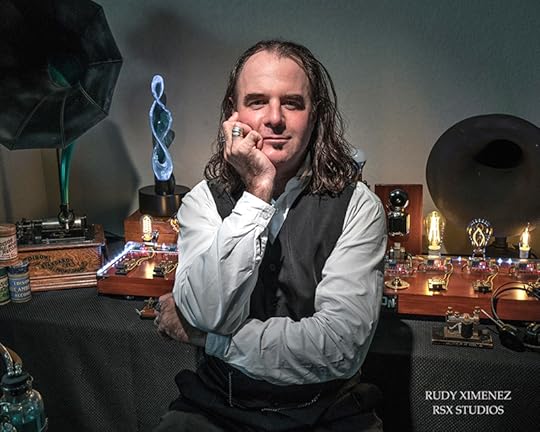
Daniel G. Benes Bio
Award-winning science popularizer and show host, Daniel G. Benes, has designed and taught numerous family-friendly, science-based shows, classes, camps, and enrichment programs at schools, academies, libraries, museums, and events across the state of Texas. Daniel’s Interactive Science and Antique Technology Exhibits have been awarded four Staff-Pick Blue Ribbons by Maker Faire Austin and have been featured at SXSW Interactive. Daniel has been featured in TV and radio programs on Discovery Channel, History Channel, NBC, CBS, NPR, and in numerous magazines including Georgetown View, Hill Country View, Texas Monthly, and the New York Times. He is a former two-time Austin FM radio show host and producer with over a million syndicated listeners in Austin and Seattle. He has worked in Aerospace as a flight avionics technician and is a former SAR Emergency Medical First Responder and Fireman. Daniel has taught Outdoor Wilderness Survival/Bushcraft skills and has competed in the Archeolympics Primitive Skills Competition.
Besides being a science showman, Daniel is also a long-time multi-instrumentalist music composer and recording artist (keyboards, synths, Native American/World flutes, duduk, percussion) with two albums to his name. He was the winner of the 2010 People’s Choice music competition for best instrumental. In fact, it is Daniel’s music that St. David’s Hospitals play each time a baby is born! He is also an award-winning nature & wildlife photographer, with clients including Texas Parks & Wildlife. Daniel is a member of W.A.T.T.—World Association of Technology Teachers, and is a lifelong learner devoted to inspiring others.
Official Website: www.scienceshows.tech
Official Facebook Page: http://facebook.com/scienceshows.tech
YouTube Channel: https://youtube.com/dgbnops
Instagram: @scienceshows.tech https://instagram.com/scienceshows.tech/
Booking & Info: scienceshows.tech@gmail.com
The post Fun Science with Daniel G. Benes appeared first on Author Don Winn's Blog.
November 30, 2021
Book Buying Gift Guide
Book buying gift guide: Here’s a quick shopping guide to some great books your friends or family might enjoy receiving as a gift this year…or maybe you just want to treat yourself.
For Parents and Educators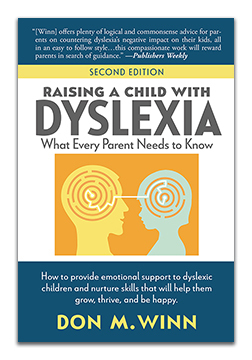 The perfect handbook for parents and teachers of dyslexic learners
The perfect handbook for parents and teachers of dyslexic learnersWhere most books fall short—covering the emotional, social, and internal toll of dyslexia—this book excels in offering a well-rounded overview and a balanced action plan that can be started right away. If you’re looking for results, then this is a must-read.
Learn More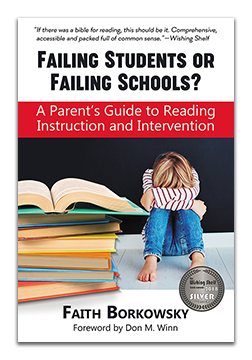 Learn why so many students fail to learn to read and how to help your child
Learn why so many students fail to learn to read and how to help your childIf you are a parent who feels the schools have failed to teach your child to read, an educator seeking greater insight into the best literacy practices for all children, or a parent of a preschooler hoping your child gets off to a good start, then this book is for you.
Learn MorePicture Books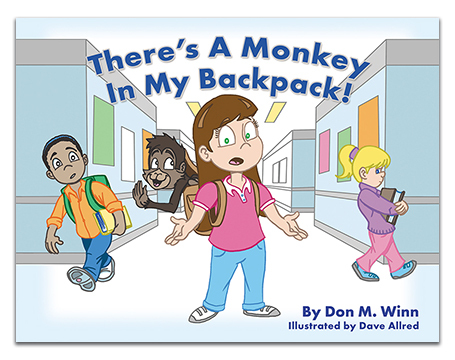 A fantastic book for explaining dyslexia to preschoolers
A fantastic book for explaining dyslexia to preschoolers“A wonderfully fun and clever way for a dyslexic child to understand why learning can be difficult.” —A Wishing Shelf Book Review
This boldly illustrated book is a great read-aloud for starting conversations about dyslexia. In this story, a monkey representing dyslexia is Anna’s constant companion. Although dyslexia makes a lot of difficulties for her, it also helps her in many ways she initially did not suspect.
Learn More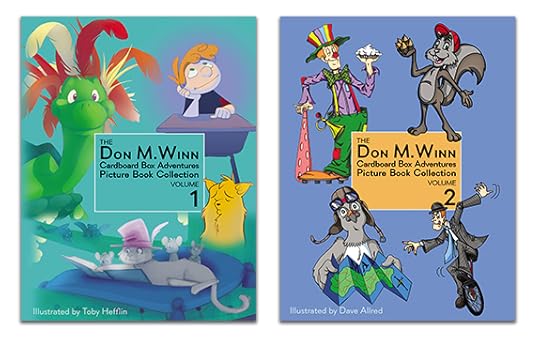 The best of Cardboard Box Adventures picture books
The best of Cardboard Box Adventures picture booksVolumes 1 and 2 of the Don M. Winn Cardboard Box Adventures Picture Book Collections each feature four classic modern fables, ideal for teaching and discussing. View the videos below for more information about the individual stories in each book.
The Tortoise and the HairpieceThe Incredible Martin O’SheaShelby the CatThe Watch CatLearn More about Volume OneChipper the ClownChipper and the UnicycleThe Higgledy-Piggledy PigeonTwitch the Squirrel and the Forbidden BridgeLearn More about Volume TwoChapter Books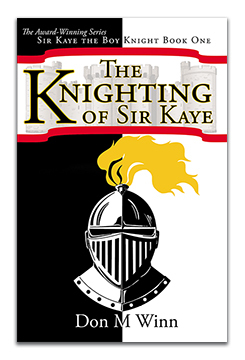 From an eleven-year-old reader:
From an eleven-year-old reader:“This is my new favorite book. It’s adventurous, funny, and taught me about being chivalrous. I also like that it is a series because instead of just having one book, you get several, and so the adventure continues.”
Learn MoreWhen wicked and heroic knights clash, one ordinary boy uncovers an extraordinary destiny… “A fantastic, fun-filled adventure. Highly recommended.” —Wishing Shelf Book Awards
Wicked knights roam the land of Knox since the death of the king—they go where they want, do what they want, take what they want, and never help anyone but themselves.
The new young queen dreams of a band of chivalrous knights who will protect her people from danger. Meanwhile, in a village on the edge of a distant forest, twelve-year-old Kaye dreams of one day becoming a heroic knight like his father.
A good deed, a daring rescue, and a queen’s risky plan change everything for Kaye. Now newly knighted, he and his best friend Reggie must face his father’s oldest enemy—the mighty Sir Melchor. Can they triumph over him in the castle tournament, or will they disgrace the queen forever?
Perfect for fans and graduates of the Magic Treehouse The Knight at Dawn, the Magic Treehouse the Merlin Missions books, and The Boxcar Children books. Also ideal for fans of Lemony Snicket’s A Series of Unfortunate Events.
Winner of six book awards, including best series, this chapter book for ages 8–12 reminds readers that there’s more to being a knight than being an adult. Kindness, courage, and valor know no age. Filled with humor, heart, fun, and adventure, this book makes a perfect gift! Instill a life-long love of reading in your child with this tale of courage, friendship, and kindness.
Books in the Sir Kaye series include Book One: The Knighting of Sir Kaye, Book Two: The Lost Castle Treasure, Book Three: Legend of the Forest Beast, Book Four: The Eldridge Conspiracy, and a companion story called Mystery of the White Knight, a shorter stand-alone eBook.
The four main Sir Kaye books are available in softcover, hardcover, eBook, and audio book format. Mystery of the White Knight is available as an eBook or audio book.
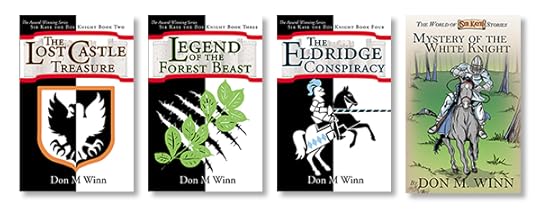
Please share this book buying gift guide with anyone you think might like to know about these books!
The post Book Buying Gift Guide appeared first on Author Don Winn's Blog.
November 23, 2021
Volcanoes in Texas!
A Trip in Time: Volcanoes in Texas!
You can listen to this blog.In my previous blog on the geological story of Texas, Dinosaurs and Sea Creatures in Texas, I took a brief foray into exploring the fossil record. I was amazed to learn about the dinosaurs that once roamed the state and the massive ocean teeming with life that once covered much of what is now dry (okay, very dry) land. But there is still much more to read in that record, and it is a story that is punctuated by incredible changes in the landscape and violent volcanic eruptions.
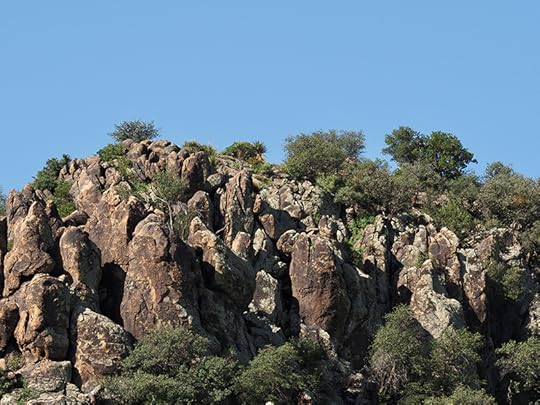 Pillars of lava rock formations closeup from Ft. Davis
Pillars of lava rock formations closeup from Ft. Davis
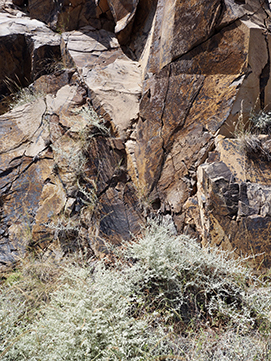 Igneous rock and lava flow near Alpine, Texas
Igneous rock and lava flow near Alpine, TexasImagine you are driving south from Alpine, Texas on State Highway 90, going towards Marfa. Just a country road like any other? No, in fact, you are driving over the collapsed crater of the Paisano volcano. There’s even a rest area along the way where you and your family can park and read more about volcanoes in Texas. The Big Bend Snapshot of History Project has a QR code available onsite. If you scan it, you can access animations that depict what happened long ago on the very ground you’re standing on, along with recent videos of modern volcanic activity.
As you watch the modern-day videos of volcanoes erupting, lava flow, magma, and ash clouds, it is astounding to imagine that those very same events—hundreds of them—took place all over the state of Texas. Watching it is amazing when you realize that without the buffer of time, your experience on that square of earth would have been quite different.
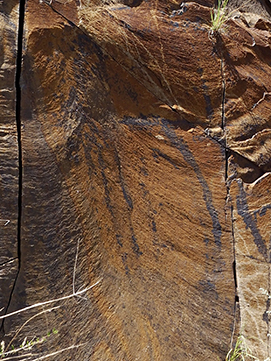 Close up of lava flow near Alpine, Texas
Close up of lava flow near Alpine, TexasThe tectonic plates were also crashing into one another, the oceanic plate forcing itself under the continental plate, and that really got things going. When shifts like these occur, water comes along for the ride, and that’s where volcanic activity begins.
How does water make the difference? Water destabilizes everything by lowering the melting point of rocks, and that creates magma. Magma is the term for melted and semi-melted rock. The more rocks melt, the more they expand, pushing the earth’s crust up from underneath with extraordinary force. Magma can reach temperatures between 1,292 degrees Fahrenheit and 2,372 degrees Fahrenheit. The hotter the magma, the more it expands, and the greater the pressure on the volume of magma that must find a way out.
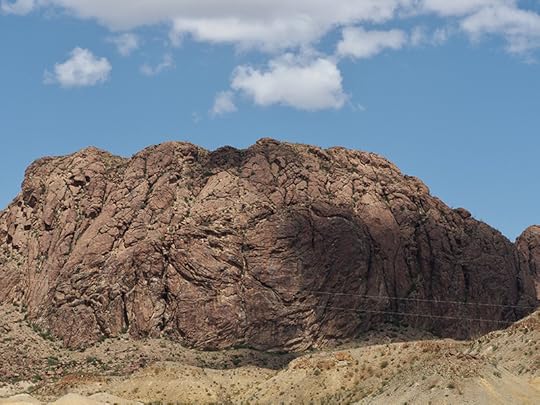 Photo of lava flow in Big Bend, Texas
Photo of lava flow in Big Bend, Texas
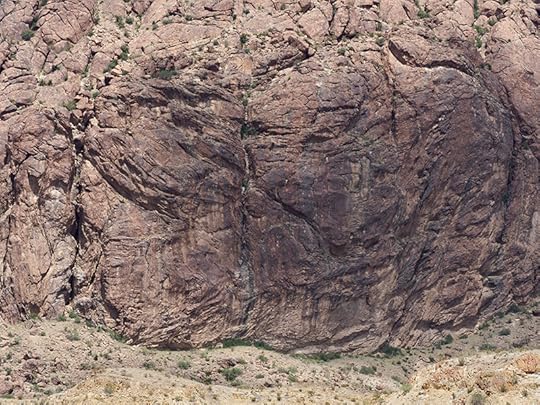 Closeup of lava flow in Big Bend, Texas
Closeup of lava flow in Big Bend, TexasAs anyone who’s ever dug a hole in Texas can attest, the ground here is heavy and hard. How much pressure coming up from beneath the earth’s crust would it take to force the ground to rise over 2,000 feet? How much energy and brute force? And yet, that is exactly what happened at the Paisano volcano.
But volcanic activity in Texas got even more powerful than that. The largest and most cataclysmic event happened in far southwest Texas, in what is now known as the Chianti mountains. The remains are there for folks to see, in a place called Mitchell Mesa Tuff. What looks now to be a beautiful and dramatic cliff face above a desert plain was once a volcanic giant. It is humbling to contemplate that, had any of us been present the day this giant blew, we would have been vaporized instantly. It buried thousands of square miles of Texas under hundreds of feet of ash and left a 240-square-mile hole in the ground.
In contrast, the explosion of Mount St. Helens in 1980 left a crater one mile wide by two miles long. Some of us were alive to see that eruption, and we were glued to our televisions as we watched a natural force so epic and frightening it captivated the nation. The Mitchell Mesa event makes the 1980 volcano look like a test run in miniature. Most of us simply can’t imagine that much raw power in nature, and what it would mean to all life forms if an event of that scale took place now.
Some of the best places to view the story in the rocks are road cuts—passages where roads have been cut through uneven terrain, exposing the inside of a hill or mountain. There is spectacular evidence of the volcanic history of west Texas around Alpine, Fort Davis, and around Big Bend. When we get curious about what the land around us has to tell us, it really is one of the most enjoyable (and accessible) forms of time travel.
If you would like to learn more about volcanoes in Texas, here are links to some helpful references:
https://visitbigbend.com/category/history/snapshots/
https://www.usgs.gov/news/history-texas-under-your-feet-and-your-fingertips
https://www.volcanodiscovery.com/earthquakes/texas.html
https://tpwd.texas.gov/state-parks/chinati-mountains
https://nmgs.nmt.edu/publications/guidebooks/downloads/31/31_p0205_p0211.pdf
Cardboard Box Adventures picture books are great for shared reading and can help parents establish a strong preliteracy foundation for their children. Check out the CBA Catalog for a full list of award-winning picture books, chapter books, and resources for parents and educators. Visit my Amazon author page for more information.
The post Volcanoes in Texas! appeared first on Author Don Winn's Blog.
November 9, 2021
Dinosaurs and Sea Creatures in Texas!
A Trip in Time: Dinosaurs and Sea Creatures in Texas!
You can listen to this blog.Everyone loves great stories. Few things captivate us like an intriguing plot with lots of well-written characters, and reading such stories is one of life’s greatest pleasures. But there are other stories all around us, stories written in the earth itself, that have taken place slowly but inexorably over millions of years. These stories tell the tale of great dinosaurs and sea creatures in Texas, of all places!
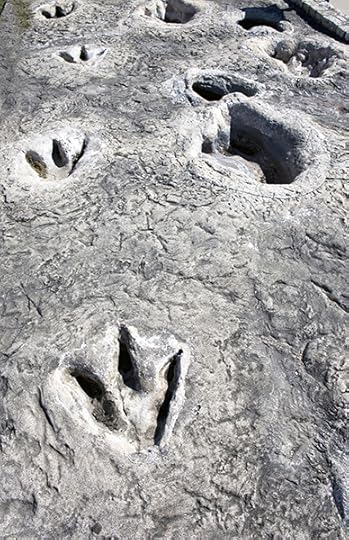
My curiosity was piqued recently during a road trip through West Texas. The landscape is an exciting change of scenery from where my wife and I live near Austin. It was so much more than an enjoyable drive; it was a complete reset of our personal perspective on time and place.
I am no geologist, but I want to share some of the fascinating aspects of the story I was able to learn about and see.
To begin with, Texas once was home to dinosaurs! From Big Bend to Canyon Lake, to Glen Rose, and as far north as the Texas Panhandle, fossils and footprints tell a story of at least twenty-one different species of dinosaurs. What a fun project it would be for families to acquaint themselves, either in person or remotely, with the history of these sites, and imagine what Texas would have looked and sounded like during these ancient times. No one knows precisely how long these powerful life-forms trod the earth, but at some point they vanished. What comes next in the geological story of Texas is remarkable and surprising.
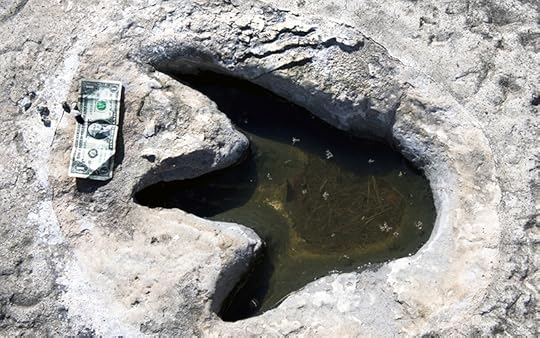
In the next chapter of our story, western Texas, Northern Mexico, and parts of southeastern New Mexico were covered by an ocean. In fact, the highest peak in Texas, Guadalupe Peak, is actually a shelf of a coral reef. This reef built itself up around the 1,000-foot-deep Permian Basin! What we know as Guadalupe Peak was at one time under more than 100 feet of water. The peak is over 8,700 feet high. Imagine how long the skeletons of the life forms that created this reef would have had to stack up on one another to reach this massive size? It makes the span of a human’s life seem like a blink in time by comparison.
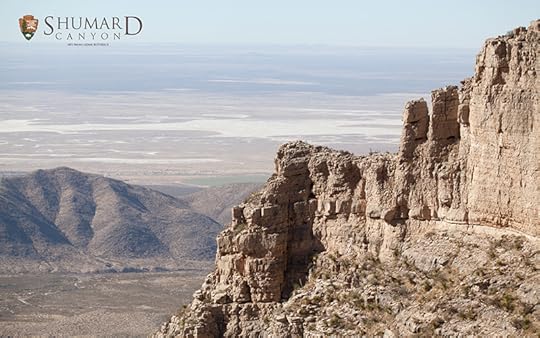 NPS Photo – Guadalupe Mountains National Park
NPS Photo – Guadalupe Mountains National ParkThere is an excellent virtual Field Trip of this historic region here. https://geoinfo.nmt.edu/tour/federal/parks/PermianReef/home.html
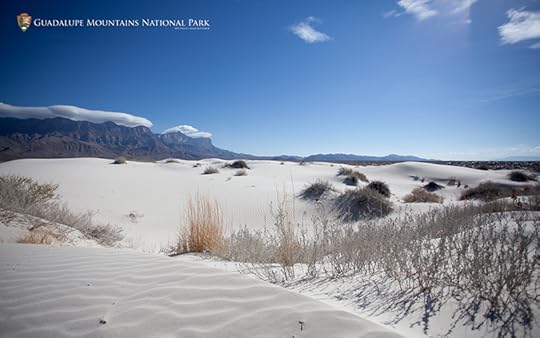 NPS Photo – Guadalupe Mountains National Park
NPS Photo – Guadalupe Mountains National ParkWe drove for hours to cross this part of Texas! It is mind boggling to think that for an unimaginable length of time all that space wasn’t even dry land! We’re talking over 86,000 square miles, or an area roughly 250 miles wide and 300 miles long. For a frame of reference, that’s more than two-and-a-half times larger than Lake Superior, the world’s largest lake as measured by surface area.
Another way to understand the massive size of this ancient body of water is that it was larger than the entire state of Minnesota, or more than twice the size of Pennsylvania. And was it ever teeming with life! Over 500 different forms of fossil life are found in the area. There were even so-called “living rocks,” stromatolites, that contributed oxygen to the atmosphere.
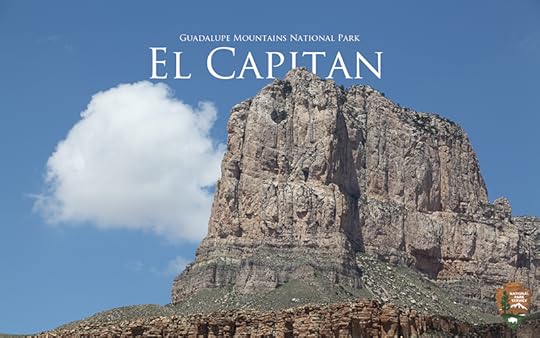 NPS Photo – Guadalupe Mountains National Park
NPS Photo – Guadalupe Mountains National ParkThe National Parks Service has published a guide to the geological clues of the Guadalupe Peak area here: https://www.nps.gov/gumo/planyourvisit/upload/Permian-Reef-Trail-Brochure_FINAL.pdf
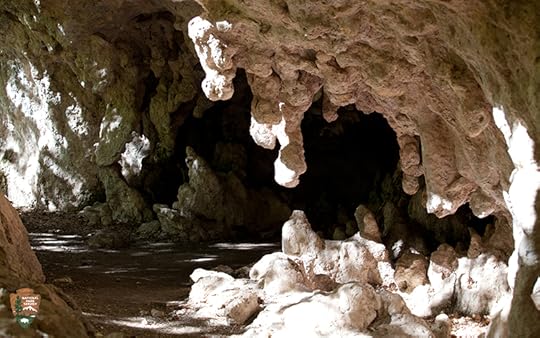 NPS Photo – Guadalupe Mountains National Park
NPS Photo – Guadalupe Mountains National ParkAs if that weren’t enough excitement, our geological thriller has another major chapter: volcanoes! Believe it or not, the state of Texas has abundant stories to tell us through the geological lens of a violent time of upheaval and tectonic shifts that took place long after the waters of the Permian Basin were nothing but a dusty memory.
But you’ll have to wait for the next installment of this blog to learn about the volcanic activity of this fascinating part of the world. It’s a real cliff-hanger!
Further Information about Dinosaurs and Sea Creatures in Texas, listed in order of reference:
https://www.traveltexas.com/articles/post/initial-formation/https://www.livescience.com/15570-ancient-coral-reef-texas-mountains.html/https://en.wikipedia.org/wiki/Permian_Basin_(North_America)https://geol105b.sitehost.iu.edu/images/gaia_chapter_10/stromatolites.htm?viewType=Print&viewClass=Printhttps://nmgs.nmt.edu/publications/guidebooks/downloads/31/31_p0205_p0211.pdfhttps://pubs.geoscienceworld.org/gsa/geology/article-abstract/16/6/509/190604/Widespread-lavalike-silicic-volcanic-rocks-ofCardboard Box Adventures picture books are great for shared reading and can help parents establish a strong preliteracy foundation for their children. Check out the CBA Catalog for a full list of award-winning picture books, chapter books, and resources for parents and educators. Visit my Amazon author page for more information.
The post Dinosaurs and Sea Creatures in Texas! appeared first on Author Don Winn's Blog.
October 26, 2021
Dyslexia and the Visual Brain
Dyslexia and the Visual Brain
You can listen to this blog.If you ask me, life is too full of acronyms as it is. And today we’re discussing yet another one. But this one refers to an important area of the brain to understand, especially as it relates to dyslexia and the visual brain. So let’s begin! And as always, the links to the studies referred to below are at the end of the article if you’d like to dig deeper.
The Visual Word Form Area (VWFA) of the brain is considered to be the brain’s “letterbox.” It’s job? Processing written letters and words and transmitting this information to higher-order language regions of the brain for linguistic processing. Translation: it learns to distinguish between different sounds of each letter, and then helps connect those various sounds to the words on a page. Those are already pretty complex processes, and yet there appears to be even more to this part of the brain than we once thought.

A 2019 study on the workings of the VWFA done at Stanford University points to a number of interesting possibilities. What the scientists discovered is that not only does the VWFA connect speech sounds with written language, but it is also a key player in attention (focus) in both vision and spatial perception. What does this mean when translated? That the VWFA helps us orthographically (it recognizes words), but it is also consistently activated by faces and numerical symbols. In fact, the data show that it is actually much more active in deciding where the brain’s attention goes than its work towards word recognition.
The scientists conclude:
“We adopted a network connectivity approach to understand the properties of distributed circuits in a putatively functionally-specialized region. We examined structural and functional connectivity with high-resolution imaging in a large cohort to test competing models of VWFA function with a strong theory-driven approach.
“Converging results indicate that VWFA is tightly coupled to both language and attention networks in the brain, and that language and attentional abilities are reflected in connectivity patterns between VWFA and their respective networks. Results strongly suggest that VWFA is not specialized just for reading and language function, but rather plays a broader role in integrating language and attention. Taken together, our study highlights the multiplexed VWFA circuits underlying reading, a highly demanding visual decoding task that requires rapid online visual perception, attention, eye movement coordination, and conversion to language representations.
“Finally, our approach is very much in resonance with the broader framework of ‘connectivity fingerprints’ or ‘connectivity constrained cognition.’ Consistent with this framework, we demonstrated that the specific functions of VWFA are very likely to depend on its functional and structural connectivity patterns with other brain networks. This organizational principle may also be useful for elucidating the functions of other brain regions.”
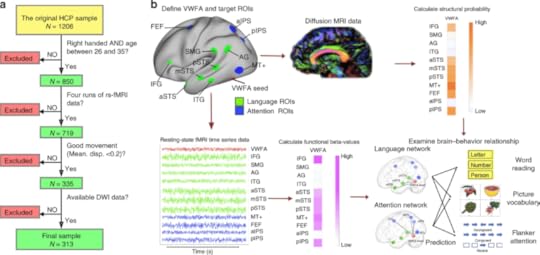
Could this be why so many of us dyslexics have such an epic struggle to focus on reading tasks, and why our recall of what we’ve read is also problematic? It certainly seems likely that the two are related.
The second study referenced below addresses another aspect of VWFA function. Since the VWFA starts interpreting sounds even before a child is exposed to very much written language, and since the activity of the VWFA appears to be less robust in children who later develop dyslexia, focusing on phonemic awareness can be a point of action.
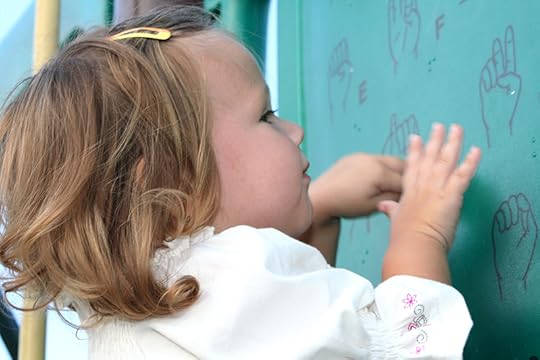
I am reminded of all I’ve learned from Faith Borkowsky, reading teacher and dyslexia expert, about the power of using a multisensory learning environment to help struggling readers. Since decoding sounds can be problematic, and visual decoding and attention are also at issue, the addition of kinesthetic techniques can help children with VWFA impairments to add another sensory category to their learning toolbox.
If you’d like to learn more about adding kinesthetic learning opportunities in your home, please refer to my blog, Dyslexia and Kinesthetic Learning.
If you would like to learn more about dyslexia and the visual brain, here are the links to the studies and articles mentioned in this blog:
https://www.nature.com/articles/s41467-019-13634-z
https://www.sciencedirect.com/science/article/abs/pii/S0028393220302165
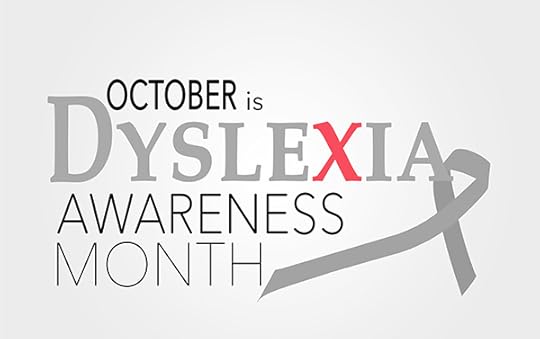
October is Dyslexia Awareness Month! For a thorough discussion of dyslexia, you may enjoy the second edition of my award-winning book Raising a Child with Dyslexia: What Every Parent Needs to Know, available in softcover, hardcover, eBook, and audio. In addition to facts on testing and accommodation, my book gives you the tools to provide the social and emotional support children with dyslexia require. The second edition has the same great content as the first edition but now contains a very helpful bibliography and index and an exciting new cover.
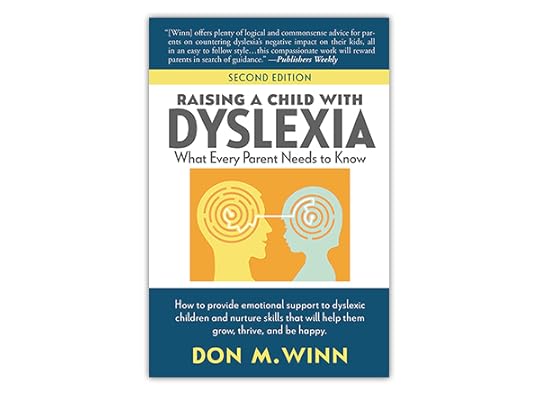
And to learn more about how every student best learns to read, you may also enjoy Failing Students or Failing Schools? A Parent’s Guide to Reading Instruction and Intervention, by reading specialist and shortlisted World Literacy Award nominee Faith Borkowsky.
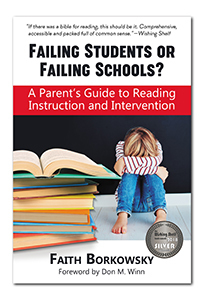
Cardboard Box Adventures picture books are great for shared reading and can help parents establish a strong preliteracy foundation for their children. Check out the CBA Catalog for a full list of award-winning picture books, chapter books, and resources for parents and educators. Visit my Amazon author page for more information.
The post Dyslexia and the Visual Brain appeared first on Author Don Winn's Blog.
October 19, 2021
Dyslexia and the Reading Brain
Dyslexia and the Reading Brain
You can listen to this blog.When I was a boy, I loved taking mechanical things apart. All the moving parts that created a functioning clock, watch, radio, and so on just fascinated me. I was always amazed that something so small could contain so many tiny moving parts that all worked together to do something meaningful.
I still love understanding how things work. For the last ten years or so, I’ve been especially interested in studying brain science, especially as it relates to dyslexia and other conditions that impact learning.

As it turns out, learning to read requires multiple parts of the brain to work harmoniously together to turn our natural gift for spoken language into a decoding system for the written word. And as many of you know, the more “moving parts” something requires, the more finely tuned the machine must be to stay on task.
Taking apart an alarm clock is one thing; peering into the human brain is something else entirely. Thankfully, we live in a time when medical imaging tools such as fMRI (Functional Magnetic Resonance Imaging), PET scans (Positron Emission Tomography), and SPM (whole-brain statistical parametric mapping) can watch the brain work while a person is performing a task such as listening or reading.
What have all these high-tech gadgets revealed?
Brain Anatomy LessonThere are at least four major parts of the brain involved in learning to read and that play a role in the effect of dyslexia on the reading brain.
The first is the frontal lobe of the brain, located behind the forehead. This massive front part of the brain is responsible for helping us produce speech. It is also responsible for comprehension, understanding of grammar, and reading fluency.
Next, if you picture a pair of over-the-ear headphones, they would be sitting over the part of the brain known as the temporal lobe. Part of the temporal lobe’s job is to process the sounds we hear. The term for this is phonological awareness or phonological processing. Each of those terms means an awareness of and an ability to work with sounds in the spoken language environment. The temporal lobe needs to be very discriminating. So many sounds in language are similar to each other, and each one must be differentiated in order for us to learn language.
Finally, if we had a couple of cherries balanced atop our headphones, those would be roughly where the supramarginal and angular gyrus reside, above and slightly behind the temporal lobe. Together, these two areas comprise the inferior parietal lobe. These brain areas process spoken and written language by integrating all the necessary processes. They help us remember what each letter of our alphabet looks like when written, sounds like when spoken, and how the different letters can blend to make different sounds. These parts of the inferior parietal lobe also generate emotional responses.
Multiple studies (there are links to two of them at the end of this blog) point to some common denominators in dyslexic students. Across the board, dyslexic learners seem to face a challenge with phonological processing (the awareness of the sound structures of words). And a significant subgroup of dyslexics also has a disruption in connectivity between the four parts of the brain needed to learn to read, which greatly slows the speed at which sounds can be processed.
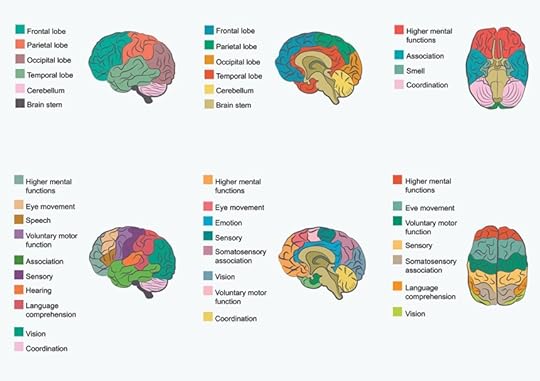 How to Nurture the Reading Brain
How to Nurture the Reading BrainWhile more studies still need to be done, just knowing about the importance of supporting your child’s phonological processing is a good place to start. How can that be done?
Read, read, read together. Expose your child to all sorts of books, stories, rhymes, and audiobooks.
Don’t be afraid to use big words around your child, or to read books together that will broaden their vocabulary. The more vocabulary words introduced to a child before they start school, the better. See my blog: Use Big Words with Your KidsWhen working with your child, help them learn the sound of each letter of the alphabet, using repetition to help them connect the visual of lines on the page to the sound the letter makes.Help children learn to break words into syllables as early in life as possible. Songs and poems are great ways to help them learn this skill, even when they are very young.If you would like more information about dyslexia and the reading brain, here are the source links for the studies mentioned in this blog:
https://pubmed.ncbi.nlm.nih.gov/12015234/
https://www.pnas.org/content/100/5/2860.abstract

October is Dyslexia Awareness Month! For a thorough discussion of dyslexia, you may enjoy the second edition of my award-winning book Raising a Child with Dyslexia: What Every Parent Needs to Know, available in softcover, hardcover, eBook, and audio. In addition to facts on testing and accommodation, my book gives you the tools to provide the social and emotional support children with dyslexia require. The second edition has the same great content as the first edition but now contains a very helpful bibliography and index and an exciting new cover.

And to learn more about how every student best learns to read, you may also enjoy Failing Students or Failing Schools? A Parent’s Guide to Reading Instruction and Intervention, by reading specialist and shortlisted World Literacy Award nominee Faith Borkowsky.

Cardboard Box Adventures picture books are great for shared reading and can help parents establish a strong preliteracy foundation for their children. Check out the CBA Catalog for a full list of award-winning picture books, chapter books, and resources for parents and educators. Visit my Amazon author page for more information.
The post Dyslexia and the Reading Brain appeared first on Author Don Winn's Blog.
October 5, 2021
The Multiple Deficit Model of Dyslexia
The Multiple Deficit Model of Dyslexia
You can listen to this blog.A few years ago, my wife and I drove her parents to Houston in their new van. It was a top-of-the-line Honda, spacious and comfortable, but my wife’s stepdad didn’t feel able to manage Houston traffic, so we agreed to help them out. During our stay, we encountered torrential rains. One afternoon as my wife was driving, she turned a corner, and the power steering and power brakes completely disengaged.
The car was uncontrollable. We were at least a half-hour away from our hotel, stuck in a major downpour, and the car could not be steered. It was like trying to coax a 4,000-pound cinder block to perform ballet. We were all screaming in fear—the steering and brakes failed every single time the car was in more than a couple of inches of water. And since the water was always deepest at intersections full of traffic, it was quite an exciting ride.
We found out later that the car had several problems. There were a couple of factory recall items and some other contributing factors that made the car only functional in dry weather. If any part of the undercarriage got wet, the entire electrical system shorted out for the duration of the moisture contact.
Here’s the point: it’s not uncommon for a problem or an issue to have more than one contributing cause. And dyslexia and its sibling conditions also have multiple contributing causes.
Why is this important? Because the more we understand the possible factors and their interactions that can contribute to dyslexia, dysgraphia, dyscalculia, dysphonia, and dyspraxia, the better our screening procedures will be, and the earlier intervention can begin. In fact, scientists who study these factors envision a world in which infants and toddlers who exhibit enough of these factors early in life can begin to receive interventions even before dyslexia has manifested itself.

I recently found a study by some of these research scientists that I want to share with you today. But before I do, please note the following points.
First, researchers call these multiple factors “comorbidities.” This might seem like a negative term, but it is the standard term used in science and health research for any issue that has more than one contributing cause.
And second, this study focuses on something called “the multiple deficit model.” In science, a model refers to a possible explanation of why something occurs. The multiple deficit model of dyslexia (MDM) stands in contrast with early models of dyslexia that theorized it is caused by a single event or risk factor.
Many parents could object to the word “deficit,” especially when applied to their child, and yet, again, this is a standard medical/scientific term used to describe anything that isn’t working in an expected way.
Therefore, the quotes and references taken from this study are not in any way being used to make people with dyslexia or those who love them feel bad, or feel guilty, or lower their expectations. Dyslexia offers many strengths, and they are not the focus of this study. Instead, the following material drills down into the possible environmental causes of dyslexia so as to facilitate earlier accommodation, something we can all agree is of paramount importance.
And finally, all the statistics and conclusions cited in this blog are taken from other studies listed in the bibliography of the multiple deficit model of dyslexia study linked at the end of this page.
Researchers at the University of Oxford and the University of Amsterdam set out to answer the question, “Which children develop dyslexia?” While seven earlier studies link a strong heritability factor, (34–66% of kids with one dyslexic parent develop dyslexia themselves), not all kids with that risk factor do develop dyslexia. Curious, isn’t it? So dyslexia is not influenced only by genetics. What else could be at play, then?
There’s a widely-accepted catchphrase in science that states, “genetics loads the gun, the environment pulls the trigger.” In scientific parlance, genotype and phenotype. Genotype refers to the genes passed down from one generation to the next. Phenotype refers to the way a person’s genes respond to their environment. Or more specifically, the set of observable characteristics of an individual resulting from the interaction of their genotype with the environment.
So this study seeks to unpack the connections between both parents and their children in the proposed intergenerational MDM, in which both parents confer the possibility of dyslexia via intertwined genetic and environmental pathways.
A number of previous studies point to the possibility of polygenicity, or many genetic contributors. Speech-sound deficits, deficits in math and sequencing, sensory processing challenges, movement/muscle control issues, and attention and focus challenges each appear to have multiple genetic risk factors with some overlap.
For example, there is considerable overlap between processing speed issues and dyslexia and ADD/ADHD. Additionally, the authors note, “roughly 70% of the genes associated with reading ability are generalists: they also influence other learning abilities.” It stands to reason that the more genetic challenges a person is born with, the lower their tolerance to environmental influences.
It’s also important to note that the term environmental influence is in no way an accusation of neglect or fault on the part of a parent. For example, if a parent is working three jobs to put food on the table, they will be much less likely to be able to spend large amounts of time creating a rich learning environment for their child.
As the authors state, “These etiological factors produce the behavioural symptoms of developmental disorders by influencing the development of relevant neural systems and cognitive processes. Importantly, there is no single etiological or cognitive factor that is sufficient to cause a disorder.”
The authors continue, “From the MDM it follows that children at family risk experience at least some of the etiological risk factors: they inherit genetic risk factors and might experience a less rich literacy environment. Hence, it is hypothesized that at-risk children have a higher genetic and environmental liability than children without a family history of dyslexia (labeled control children). Furthermore, the at-risk children who go on to develop dyslexia are expected to show cognitive deficits (to varying degrees) in several processes. Some of these cognitive processes are expected to be affected even before the onset of reading instruction, as a consequence of etiological risk factors and deficient neural systems.
A key prediction of the MDM for family risk studies concerns the at-risk children who do not develop dyslexia. If liability to dyslexia were discrete (as would happen if only one factor, say a gene, were involved), at-risk non-dyslexic children would not differ from controls. However, according to the MDM, liability is continuously distributed. This also follows from the fact that reading ability is influenced by many genes of small effect, producing normal distributions of phenotypes (Plomin et al., 2008, p. 33).
Consequently, the MDM predicts that at-risk children without dyslexia also inherit at least some disadvantageous gene variants from their dyslexic parents, giving them a higher liability than control children, although still lower than at-risk dyslexic children. At the behavioural and cognitive level, this should translate into mild deficits in literacy skills and some of its cognitive underpinnings.”
Whew, that was a lot of science, but the multiple deficit model of dyslexia holds promise for helping researchers flag early indicators of dyslexia.
What’s the take-away from the multiple deficit model of dyslexia?The development of dyslexia has a lot of moving parts. In addition to multitudes of different genes contributing to dyslexia, a number of environmental factors exert a measurable influence as well.
What are the challenges? Several.
First, the more contributing factors to a condition, the harder it becomes to screen for the condition. It’s not like taking a throat swab to see if you have strep throat or not. The entire picture of a child’s family, their learning and processing styles, their home environment, their attitudes and practices around reading, math, physical activities, and more all play a role. Did the child have the opportunity to develop a preliteracy foundation?
(To learn more about building a preliteracy foundation, see my blogs What Is Preliteracy, and When Can Parents Begin to Build It? and Shared Reading and Parental Vocabulary as Preliteracy Tools.)
Second, most parents are already doing all they can to enrich their child’s lives. And what if reading aloud with your child is difficult for you? Or what if you struggle to focus? Or what if you’re overwhelmed with earning a living? This information isn’t intended to stress you out or cause you to have regrets. Instead, it’s meant to point out opportunities that are still available to provide help for your child for which you can ask for help yourself.
Perhaps you’ve heard the phrase “it takes a village to raise a child.” Do you have extended family who can help with reading aloud and other interactions? What about friends and neighbors? What community programs exist at your public library? Many online sources of free audiobooks are available to help keep great stories available to struggling readers. Here’s a link: https://bookriot.com/11-websites-find-free-audiobooks-online/

The third challenge can be a lack of information. If a parent does not understand dyslexia, that parent will have difficulty addressing the challenges of dyslexia. Did you know that there are at least 9 documentaries or films that feature dyslexia? Watching them as a family creates a framework of understanding and hope, which can otherwise feel in short supply. Here’s a link: https://www.understood.org/articles/en/9-films-that-feature-dyslexia
Don’t forget, I write this blog to be a free resource for families who are dealing with dyslexia and all its sibling conditions. Please dive into the Dyslexia Articles archives to find answers to your questions.

October is Dyslexia Awareness Month! For a thorough discussion of dyslexia, you may enjoy the second edition of my award-winning book Raising a Child with Dyslexia: What Every Parent Needs to Know, available in softcover, hardcover, eBook, and audio. In addition to facts on testing and accommodation, my book gives you the tools to provide the social and emotional support children with dyslexia require. The second edition has the same great content as the first edition but now contains a very helpful bibliography and index and an exciting new cover.
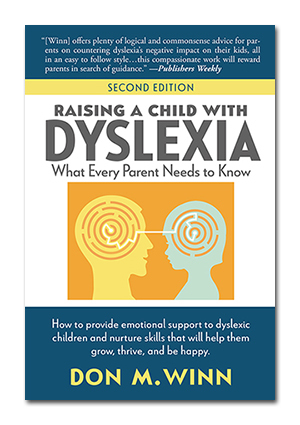
And to learn more about how every student best learns to read, you may also enjoy Failing Students or Failing Schools? A Parent’s Guide to Reading Instruction and Intervention, by reading specialist and shortlisted World Literacy Award nominee Faith Borkowsky.

Cardboard Box Adventures picture books are great for shared reading and can help parents establish a strong preliteracy foundation for their children. Check out the CBA Catalog for a full list of award-winning picture books, chapter books, and resources for parents and educators. Visit my Amazon author page for more information.
Link to the featured study about the multiple deficit model of dyslexia:
https://www.frontiersin.org/articles/10.3389/fnhum.2014.00346/full
The post The Multiple Deficit Model of Dyslexia appeared first on Author Don Winn's Blog.



